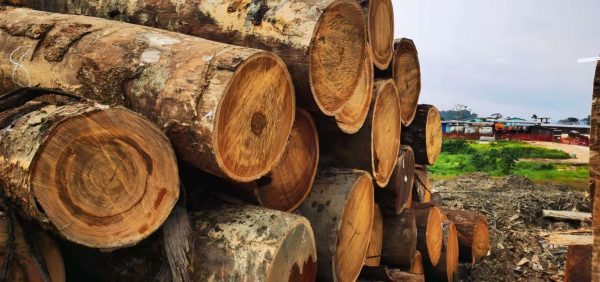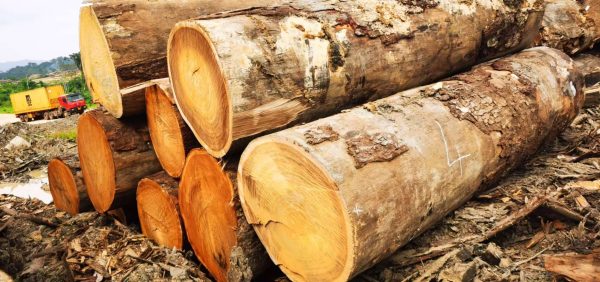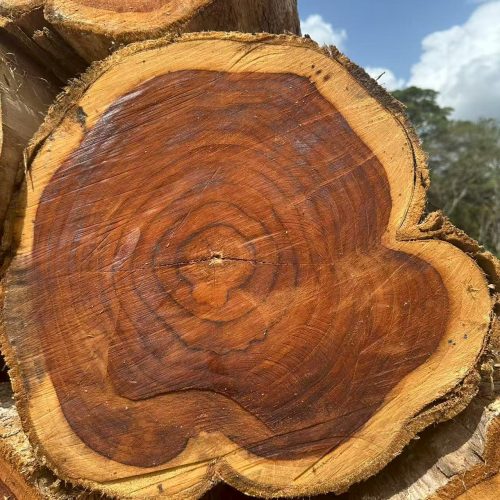Tail Wood Overview
Tali round logs are premium hardwood logs highly regarded across the global market, celebrated for their robust durability, dense fiber structure, and warm golden-brown to deep reddish-brown hue. Sourced from lush tropical forests in West Africa—with a primary focus on Nigeria—these round logs offer distinct advantages: their cylindrical shape is ideal for crafting rustic architectural elements, curved structural components, or decorative log features, while their inherent strength makes them reliable for load-bearing uses. Unlike ordinary hardwood logs, Tali’s natural resistance to decay and wear elevates its suitability for projects that demand both longevity and a touch of natural elegance.
Physical Properties
– Density: 890–950 kg/m³ (at 12% moisture content) – Delivers a solid, heavyweight feel that ensures strong structural dependability, making it suitable for heavy-duty load-bearing tasks and high-wear applications.
– Janka Hardness: 1,820 lbf (8,090 N) – Offers excellent resistance to dents, scratches, and daily wear, keeping its appearance intact even in high-traffic or frequently used settings.
– Color: Heartwood ranges from warm golden-brown to deep reddish-brown, often developing subtle rich undertones over time; sapwood is pale yellowish-white, creating a clear visual contrast with the heartwood. With age and light exposure, the heartwood darkens gently, taking on a more sophisticated, mature look.
– Grain: Typically straight to slightly interlocked, with a fine to medium texture and a natural, soft luster that becomes more pronounced after finishing. The subtle variations in grain add depth and character to the wood’s visual appeal.
– Durability: Recognized as a highly durable hardwood, Tali boasts exceptional resistance to decay, rot, wood-boring insects, and moisture damage. It performs reliably even in outdoor or semi-protected environments, thanks to its dense structure.
– Shrinkage: Radial shrinkage of 4.5%, tangential shrinkage of 7.8%, and volumetric shrinkage of 12.5% – These stable shrinkage rates ensure minimal dimensional changes, making the round logs highly predictable and stable for long-term installations.
Tali Wood Workability
– Machining: Tali’s high density and occasional interlocked grain can pose slight challenges during machining. To achieve smooth surfaces and reduce tear-out, use sharp, high-quality tools (preferably carbide-tipped) and maintain steady, moderate cutting speeds for precise shaping.
– Gluing: While Tali’s density may initially impact adhesive bond strength, proper surface preparation—such as light sanding to remove dust and excess natural oils—allows it to bond well with high-quality wood glues. This ensures strong, long-lasting joints for structural assemblies.
– Nailing and Screwing: Performs reliably with nails and screws, but pre-drilling pilot holes (especially for thicker sections of the round log or near the edges) is recommended to prevent splitting. The wood’s density ensures secure fastening that remains tight over time.
– Finishing: Takes clear finishes (like polyurethane, teak oil, or varnish) exceptionally well. Clear finishes enhance Tali’s natural color and grain while adding a protective layer against scratches and moisture; even without finishing, outdoor Tali develops a subtle natural patina that preserves its integrity.
Taliwood Applications
– Rustic Log Construction: Widely used in building log cabins, chalets, and rustic-style outdoor pavilions. The round shape retains an organic, natural aesthetic, while Tali’s durability ensures the structure withstands the test of time.
– Curved Structural Elements: Ideal for crafting curved beams, arches, and support posts in residential and commercial projects (e.g., indoor atriums, outdoor pergolas). Its strength and workability allow for seamless integration into custom designs.
– Outdoor Landscaping: Used to create garden borders, decorative log edgings, and sturdy pergola frames. Its resistance to weather and insects ensures it remains intact in outdoor settings for years.
– Marine & Waterfront Projects: A top choice for dock pilings, boat deck framing, and waterfront retaining structures. Its ability to resist moisture and saltwater-related damage makes it suitable for marine environments.
– Artisanal Crafts: Valued by artisans for creating wooden sculptures, decorative log accents, and custom outdoor furniture (e.g., rustic benches, side tables). The natural grain and color of Tali round logs add a premium, handcrafted touch to such pieces.
Tali Sustainability
– Conservation Status: Tali is not listed in the CITES Appendices, but its wild populations in some West African regions face pressure from unsustainable harvesting. In Nigeria and neighboring countries, efforts to promote sustainable forest management have become crucial to protect natural habitats.
– Environmental Considerations: We prioritize sourcing Tali round logs from sustainably managed forests in West Africa—including those accredited by the Forest Stewardship Council (FSC) or local Nigerian forestry certification programs. This ensures responsible harvesting practices that safeguard biodiversity, support local communities, and guarantee the long-term availability of Tali resources.
Why Choose Tali Round Logs?
– Exceptional Durability & Weather Resistance: Tali’s high density and natural decay resistance make it resistant to harsh weather, insects, and moisture—outperforming many hardwood logs, especially in outdoor or high-wear environments.
– Versatile Form & Strength: Combines the natural, cylindrical shape of round logs (ideal for rustic or curved designs) with Tali’s robust structural strength—perfect for projects where both aesthetic appeal and functional performance are critical.
– Low Maintenance Needs: Requires minimal upkeep; outdoor Tali round logs develop a natural patina without deteriorating, while indoor logs only need occasional cleaning to retain their beauty, reducing long-term maintenance costs.
– Sourced from Trusted Regions: Our focus on Nigerian and West African sources ensures access to high-quality Tali, supported by sustainable practices that align with environmental and social responsibility goals.












